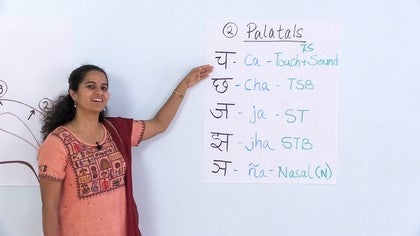Description
About This Video
Transcript
Read Full Transcript
Namaste and welcome dear friends once again. Last time we saw the way the consonants sounded and we saw that they corresponded to these five places of touch. So we had the guttural or in the throat followed by the palatals a little higher up. Then the cerebrals corresponded to the center point of the roof of your mouth and then the dentals were at the teeth and then we had the labials. So now let's see what the guttural look like.
The first guttural on our list was the k, which is a combination of touch and then sound or the vowel. So it was k, which put together becomes the k. Try that again. Did you feel it? Now let's see what it looks like.
That is the k, k and in transliteration it is written as the English k and the vowel a. k and a together make it k. What we saw as well is that it corresponded to touch plus sound. I think we can do a sort of code between us. So if it is a touch and sound, we will mark it as a t, s. So that's touch and sound.
Say that along with me. The next letter is the same aspect of touch and sound combined with your breath. So it's a k, k. One can tend to do it sometimes as a k, but avoid doing that. Make it a single sound, k, lovely.
Let's see what it looks like. So that is a k, k and in transliteration you would write it as k, h and a, k. In terms of understanding the mechanism of it, it is touch, sound and breath. The next sound that we have is the sound and touch, which means that you first hear the sound and then there is an element of touch. So it's g, g.
Try that. Yes, g, lovely. And in Sanskrit it looks like this. In the Devanagari script which is used to represent the Sanskrit sounds, it looks like this, g, g. And then when you write it in English, it is the g and the a.
And keeping our code, it is first the sound and then the touch. Okay, let's say that once more together, g, brilliant. The next letter in the series is the g, which is a combination of sound, touch and breath. See if you can get that, g, yes, okay, let's see what it looks like, g, g, lovely. In transliteration you add an h to it.
You add an h to represent the breath. It is a g. In terms of the mechanism, it would be sound, touch, breath, got that, lovely. The last letter in the series is the nasalized sound. So you have to have your touch element in your throat, just add your nose or your nasal sound to it and you get the ng, ng, try that, ng, ng.
It's a bit like what you would say with kinga, ng, it's a bit like ng, lovely. Let's see what it looks like now. That's it, lovely. And it is written with n with a dot on top and an a. So in the transliterated forms, we add these dots and little dashes and accents that you just need to pay a little attention to and you would know what letter it corresponds to and what sound it corresponds to.
This is just the nasal in terms of the mechanism or in short, we can represent it with the n. Now can we try saying that once together, k, k, g, g, n. See if you can say that, I'll point out the letter and try and say that. Super once last time, it's good to do things three times, you know at all levels the sound just settles and you have the visual, it's a complete package. So let's say together now, k, k, g, g, n, lovely.
So look forward to seeing you for the palatas, bye-bye, have a good day.







You need to be a subscriber to post a comment.
Please Log In or Create an Account to start your free trial.